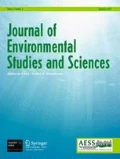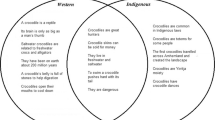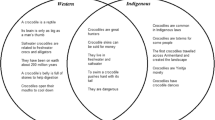Abstract
This is a process article for weaving indigenous and mainstream knowledges within science educational curricula and other science arenas, assuming participants include recognized holders of traditional ecological knowledge (we prefer “Indigenous Knowledge” or “Traditional Knowledge”) and others with expertise in mainstream science. It is based on the “Integrative Science” undergraduate program created at Cape Breton University to bring together indigenous and mainstream sciences and ways of knowing, as well as related Integrative Science endeavors in science research, application, and outreach. A brief historical outline for that experiential journey is provided and eight “Lessons Learned” listed. The first, namely “acknowledge that we need each other and must engage in a co-learning journey” is explained as key for the success of weaving efforts. The second, namely “be guided by Two-Eyed Seeing”, is considered the most profound because it is central to the whole of a co-learning journey and the article’s discussion is focussed through it. The eighth lesson, “develop an advisory council of willing, knowledgeable stakeholders”, is considered critical for sustaining success over the long-term given that institutional and community politics profoundly influence the resourcing and recruitment of any academic program and thus can help foster success, or sabotage it. The scope of relevance for Two-Eyed Seeing is broad and its uptake across Canada is sketched; the article also places it in the context of emerging theory for transdisciplinary research. The article concludes with thoughts on why “Two-Eyed Seeing” may seem to be desired or resisted as a label in different settings.
Traditional Indian education is an expression of environmental education par excellence. It is an environmental education process that can have a profound meaning for the kind of modern education required to face the challenges of living in the world of the twenty-first century (Cajete (2010), p. 1128, emphasis as in original).
As two-eyed seeing implies, people familiar with both knowledge systems can uniquely combine the two in various ways to meet a challenge or task at hand. In the context of environmental crises alone, a combination of both seems essential (Aikenhead and Michell (2011), p. 114).
Similar content being viewed by others
References
Absolon (Minogiizhigokwe) KE (2011) Kaandossiwin; how we come to know. Fernwood, Halifax
Aikenhead G, Michell H (2011) Bridging cultures; indigenous and scientific ways of knowing nature. Pearson Canada Inc, Toronto
APCFNC website. APCFNC Elders Project: Honouring Traditional Knowledge, 2009 – 2011. http://www.apcfnc.ca/en/resources/HonouringTraditionalKnowledgeFinal.pdf
Arbon V (2008) Arlathirnda Ngurkarnda Ityirnda/Being–knowing–doing; de-colonizing indigenous tertiary education. Post Pressed, Teneriffe, Australia
Archibald JA (2008) Indigenous storywork; educating the heart, mind, body, and spirit. UBC Press, Vancouver
Bartlett C (2006) Knowledge inclusivity: “Two-Eyed Seeing” for science for the 21st century. In: Wiber M, Kearney J (eds) Proceedings of the Workshop on Learning Communities as a Tool for Resource Management, 4–5 November 2005, Halifax, pp. 70–76. http://www.integrativescience.ca/uploads/articles/2005November-Bartlett-text-Integrative-Science-Two-Eyed-Seeing-Aboriginal-learning-communities.pdf. Accessed 15 Jan 2012
Bartlett C (2011) Integrative Science / Toqwa’tu’kl Kjijitaqnn: the story of our journey in bringing together indigenous and Western scientific knowledges. In: Bernard T, Rosenmeier LM, Farrell, SL (eds) Ta’n Wetapeksi’k: Understanding from where we come—Proceedings of the 2005 Debert Research Workshop, Debert, Nova Scotia, Canada, Eastern Woodland Print Communications, Truro, pp 179–186. http://www.integrativescience.ca/uploads/articles/2011-Bartlett-Integrative-Science-Mikmawey-Debert-Chapter-17-proofs.pdf. Accessed 15 Jan 2012
Bartlett C (2012) The gift of multiple perspectives in scholarship/integrative science. University Affairs 53(3):41. http://www.universityaffairs.ca/the-gift-of-multiple-perspectives-in-scholarship.aspx. Accessed 15 March 2012
Bartlett CM, Marshall A, Marshall M (2007) Integrative Science: enabling concepts within a journey guided by “Trees Holding Hands” and “Two-Eyed Seeing”. Two-Eyed Seeing knowledge sharing series, manuscript no. 1. Institute for Integrative Science & Health, Cape Breton University, Sydney. http://www.integrativescience.ca/uploads/articles/2007-Bartlett-Marshall-Integrative-Science-Two-Eyed-Seeing-Aboriginal-co-learning-trees-holding-hands.pdf. Accessed 15 Jan 2012
Bartlett CM, Marshall A, Marshall M (2008) Facilitating the “talking and walking together” of indigenous and mainstream sciences. Presentation at: Annual International Conference of the Wildlife Disease Association, Edmonton, AB, 3-8 August 2008. http://www.integrativescience.ca/uploads/articles/2008August-Bartlett-Marshall-Integrative-Science-Two-Eyed-Seeing-Aboriginal-wildlife-disease.pdf. Accessed 15 Jan 2012
Bartlett C, Marshall M, Marshall A, Iwama M (2012) Integrative science and Two-Eyed Seeing: enriching the discussion framework for healthy communities. In: Hallstrom LK, Guehlstorf N, Parkes M (eds) Beyond intractability: convergence and opportunity at the interface of environmental, health and social issues. UBC Press, Vancouver. http://www.integrativescience.ca/uploads/articles/2012-Bartlett-Marshall-Iwama-Integrative-Science-Two-Eyed-Seeing-enriching-discussion-framework(authors-draft).pdf. Accessed 15 February 2012
Berkes F (1999) Sacred ecology; traditional ecological knowledge and resource management. Taylor & Francis, Philadelphia
Blackstock C (2007) The breath of life versus the embodiment of life: indigenous knowledge and Western research. WIN-HEC (World Indigenous Nations Higher Education Consortium), 13pp http://www.win-hec.org/docs/pdfs/cindy.pdf. Accessed 27 Mar 2012
Brown L, Strega S (2005) Research as resistance; critical indigenous, & anti-oppressive approaches. Canadian Scholars’ Press, Toronto
Cajete G (2000) Native science; natural laws of interdependence. Clear Light, Santa Fe
Cajete GA (2010) Contemporary indigenous education: a nature-centered American Indian philosophy for a 21st century world. Futures 42:1126–1132
CCL website. http://www.ccl-cca.ca/CCL/Reports/RedefiningSuccessInAboriginalLearning/RedefiningSuccessModels.html. Accessed 28 Mar 2012
Cole P (2006) Coyote and Raven go canoeing; coming home to the village. McGill-Queen’s University Press, Montreal
Collier RJ (2012) Dances with words: ecosystem terminology and the Gitxsan language. Royal Roads University, Dissertation
Denzin NK, Lincoln YS, Smith LT (2008) Handbook of critical and indigenous methodologies. Sage, Los Angeles
Geniusz WM (2009) Our knowledge is not primitive; decolonizing botanical Anishinaabe teachings. Syracuse University Press, Syracuse
Hatcher A, Bartlett C (2010) Two-Eyed Seeing; building cultural bridges for aboriginal students. Canadian Teacher Magazine. May 14–17 http://www.canadianteachermagazine.com/pdf/CTM_May10.pdf. Accessed 25 Mar 2012
Hatcher A, Bartlett CM, Marshall A, Marshall M (2009) Two-Eyed Seeing in the classroom environment: concepts, approach and challenges. Can J Sci Math Tech Educ 9(3):141–153
Hipwell W (2001) Taking charge of the Bras d’Or: ecological politics in the ‘Land of Fog’. Dissertation, Carleton University
IISH website. http://www.integrativescience.ca
Iwama M, Marshall M, Marshall A, Bartlett C (2009) Two-Eyed Seeing and the language of healing in community-based research. Can J Native Educ 32:3–23
Kimmerer RW (2002) Weaving traditional ecological knowledge into biological education: a call to action. BioScience 52(5):432–438
King M (2011) Importance of “Two-Eyed Seeing”. In: Aboriginal peoples’ wellness in Canada: scaling up the knowledge cultural context and community aspirations (summary report from March 3–4th Roundtable), p 3. http://www.ihe.ca/documents/Aboriginal%20Roundtable%20Report.pdf. Accessed 15 Mar 2012
Marshall M (2008) Health and healing—death and dying: women’s roles within. Workshop training materials for cultural sensitivity and cultural humility; for health organization. http://www.integrativescience.ca/uploads/articles/2008-Marshall-cultural-sensitivity-humility-module-aboriginal-health.pdf. Accessed 15 Feb 2012
Marshall M (2011) L’nuita’si: Mi’kmaw tribal consciousness. In: Bernard T, Rosenmeier LM, Farrell SL (eds) Ta’n Wetapeksi’k: Understanding from where we come—Proceedings of the 2005 Debert Research Workshop, Debert. Eastern Woodland Print Communications, Truro, Nova Scotia, pp 173–177
Marshall A, Marshall M, Iwama M (2010) Approaching Mi’kmaq teachings on the connectiveness of humans and nature. In: Bondrup-Nielsen S, Beazley K, Bissix G, Colville D, Flemming S, Herman T, McPherson M, Mockford S, O’Grady S (eds) Ecosystem based management: beyond boundaries. Proceedings of the Sixth International Conference of Science and the Management of Protected Areas, 21–26 May 2007. Acadia University, Wolfville, Science and Management of Protected Areas Association, Wolfville, NS http://www.sampaa.org/publications/conference-proceedings-1991-2000/sampaa-6-proceedings/traditional-knowledge/Marshall%20et%20al%202010.pdf/view. Accessed 15 Mar 2012
Martin D (2009). Food stories: a Labrador Inuit–Metis community speaks about global change. Dissertation, Dalhousie University. http://dalspace.library.dal.ca/bitstream/handle/10222/12354/Martin%20Dissertation.pdf?sequence=1. Accessed 15 Mar 2012
Menzies CR (ed) (2006) Traditional ecological knowledge and natural resources management. University of Nebraska Press, Lincoln
Pohl C (2011) What is progress in transdisciplinary research? Futures 43:618–626
Sable T, Francis B (2012) The language of this land. CBU Press, Sydney, Canada
Sheridan J, Longboat (Roronhiakewen) D (2006) The Haudenosaunee imagination and the ecology of the sacred. Space and Culture 9(4):365–381
Smith LT (1999) Decolonizing methodologies; research and indigenous peoples. Zed Books, London
Stewart-Harawira M (2012) Returning the sacred: indigenous ontologies in perilous times. In: Williams L, Roberts R, McIntosh A (eds) Radical human ecology; intercultural and indigenous approaches. Ashgate, Surrey, pp 73–88
td-net website. http://www.transdisciplinarity.ch/e/conference/international/2011/. Accessed 28 Mar 2012
Williams L, Roberts R, McIntosh A (eds) (2012) Radical human ecology; intercultural and indigenous approaches. Ashgate, Surrey
Wilson S (2008) Research is ceremony; indigenous research methods. Fernwood, Halifax
Acknowledgments
We acknowledge and thank Cape Breton University for being the academic home for Integrative Science for many years. We also extend our sincere appreciation and thanks to the various other organizations that have provided support and to the many individuals who have been or continue to be participants within (or, in other ways, supporters of) the co-learning journey of Integrative Science guided by Two-Eyed Seeing. This includes numerous Elders, community members, university science students, school students, educators, scientists, and others from Mi’kmaw First Nations and organizations in Atlantic Canada, plus key people from other aboriginal communities and organizations elsewhere in Canada. Similarly, there have been many non-aboriginal elders and other people: research scientists, professors, students, research assistants, associates and fellows, and individuals in government and elsewhere outside academia. We are grateful to our various funders: Sable Offshore Energy, Inc., the Canada Research Chairs program, SSHRC, CIHR–IAPH, NSERC, IWK Health Centre Foundation, Nova Scotia Health Research Foundation, Atlantic Aboriginal Health Research Program, Mounted Police Foundation, Canadian Foundation for Innovation and Nova Scotia Research Innovation Trust Fund. We offer thanks to our Earth Mother and all our relations. Msit No’kmaq.
Author information
Authors and Affiliations
Corresponding author
Rights and permissions
About this article
Cite this article
Bartlett, C., Marshall, M. & Marshall, A. Two-Eyed Seeing and other lessons learned within a co-learning journey of bringing together indigenous and mainstream knowledges and ways of knowing. J Environ Stud Sci 2, 331–340 (2012). https://doi.org/10.1007/s13412-012-0086-8
Published:
Issue Date:
DOI: https://doi.org/10.1007/s13412-012-0086-8




